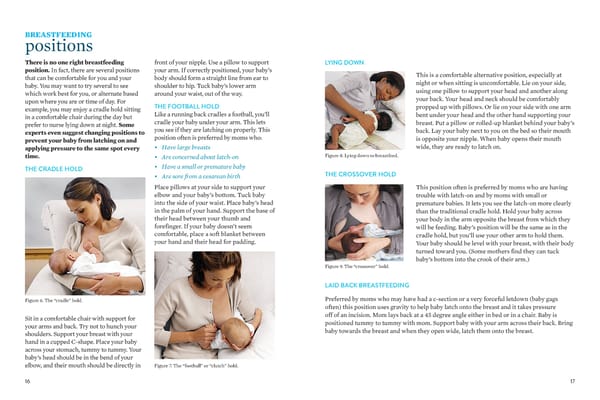BREASTFEEDING positions There is no one right breastfeeding front of your nipple. Use a pillow to support LYING DOWN position. In fact, there are several positions your arm. If correctly positioned, your baby’s This is a comfortable alternative position, especially at that can be comfortable for you and your body should form a straight line from ear to night or when sitting is uncomfortable. Lie on your side, baby. You may want to try several to see shoulder to hip. Tuck baby’s lower arm using one pillow to support your head and another along which work best for you, or alternate based around your waist, out of the way. your back. Your head and neck should be comfortably upon where you are or time of day. For THE FOOTBALL HOLD propped up with pillows. Or lie on your side with one arm example, you may enjoy a cradle hold sitting Like a running back cradles a football, you’ll bent under your head and the other hand supporting your in a comfortable chair during the day but cradle your baby under your arm. This lets breast. Put a pillow or rolled-up blanket behind your baby’s prefer to nurse lying down at night. Some you see if they are latching on properly. This back. Lay your baby next to you on the bed so their mouth experts even suggest changing positions to position often is preferred by moms who: is opposite your nipple. When baby opens their mouth prevent your baby from latching on and wide, they are ready to latch on. applying pressure to the same spot every • Have large breasts time. • Are concerned about latch-on Figure 8. Lying down to breastfeed. THE CRADLE HOLD • Have a small or premature baby • Are sore from a cesarean birth THE CROSSOVER HOLD Place pillows at your side to support your This position often is preferred by moms who are having elbow and your baby’s bottom. Tuck baby trouble with latch-on and by moms with small or into the side of your waist. Place baby’s head premature babies. It lets you see the latch-on more clearly in the palm of your hand. Support the base of than the traditional cradle hold. Hold your baby across their head between your thumb and your body in the arm opposite the breast from which they forefinger. If your baby doesn’t seem will be feeding. Baby’s position will be the same as in the comfortable, place a soft blanket between cradle hold, but you’ll use your other arm to hold them. your hand and their head for padding. Your baby should be level with your breast, with their body turned toward you. (Some mothers find they can tuck baby’s bottom into the crook of their arm.) Figure 9. The “crossover” hold. LAID BACK BREASTFEEDING Figure 6. The “cradle” hold. Preferred by moms who may have had a c-section or a very forceful letdown (baby gags often) this position uses gravity to help baby latch onto the breast and it takes pressure Sit in a comfortable chair with support for off of an incision. Mom lays back at a 45 degree angle either in bed or in a chair. Baby is your arms and back. Try not to hunch your positioned tummy to tummy with mom. Support baby with your arm across their back. Bring shoulders. Support your breast with your baby towards the breast and when they open wide, latch them onto the breast. hand in a cupped C-shape. Place your baby across your stomach, tummy to tummy. Your baby’s head should be in the bend of your elbow, and their mouth should be directly in Figure 7. The “football” or “clutch” hold. 16 17
 Breastfeeding Guide Page 8 Page 10
Breastfeeding Guide Page 8 Page 10